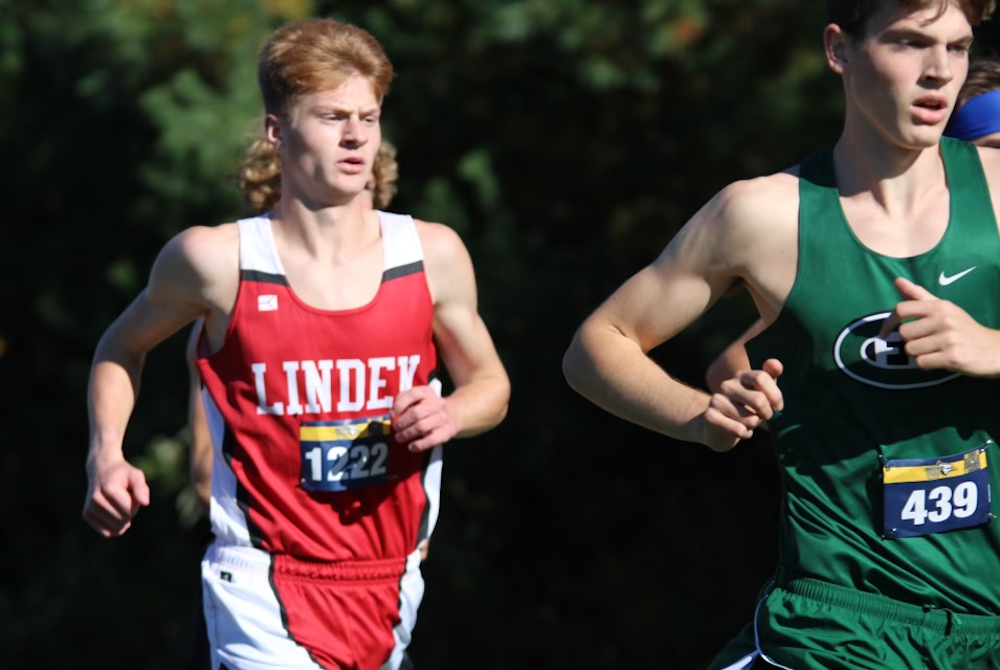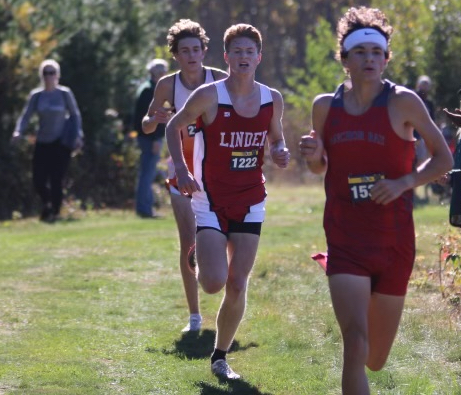
Eberhard Surpasses Personal Goals, Becomes Linden XC Standard Setter
By
Paul Costanzo
Special for MHSAA.com
October 20, 2022
Kyle Eberhard has enjoyed running for as long as he can remember.
 He joined a mileage club in elementary school. He said his days on the playground weren’t spent playing soccer like some of his classmates, but running back and forth.
He joined a mileage club in elementary school. He said his days on the playground weren’t spent playing soccer like some of his classmates, but running back and forth.
Back then, he was simply having fun and blissfully unaware of a Linden High School distance program that was among the best in the state.
Now in his senior year, that love of running helped turn him into the best distance runner the program has ever had.
“Kyle had another year of really solid mileage and had a fantastic track season (as a junior),” Linden boys cross country coach Trevor Hall said. “Coming into cross country season, he was brimming with confidence. Running consumes his thoughts. He’s always thinking about, ‘How can I be a better runner?’ He just does everything right.”
Eberhard recently set the school’s cross country record, completing the 5K course at the Shepherd Blue Jay Invite in 15 minutes, 20.9 seconds. It was nearly 30 seconds better than his previous personal best, and 14.4 seconds better than the previous record, set by Roger Phillips in 2012.
“It’s crazy because my goal was just to get on (the program’s top 10 list),” Eberhard said. “And that was starting last year – by the end of my senior year, the goal was to get on there. I never envisioned getting on the top. There was a senior when I was a freshman, Tyler Buchanan, he’s (third), and I was like, ‘I’ll never be as fast as him.’”
The record started to become a reality for Eberhard this past track season. He set the school record in the 1,600 meters at 4:18.01, was a Regional champion in the 800, 1,600 and 3,200 and was all-state at the Lower Peninsula Division 2 Finals in the 800 (fifth) and 1,600 (eighth).
Track season also showed Eberhard’s range as a runner, as he was unbeaten in six 400-meter races, including winning the Flint Metro League championship.
“I’ve been training over the winter since my freshman year,” Eberhard said. “But last winter, I went a lot harder. I raced a lot more. I really focused on racing almost every weekend, and focused on what workouts I was doing, stuff like that.”
 Track didn’t just bring confidence to Eberhard, it also brought college interest. Scholarship offers have started rolling in, including from Eastern Michigan and Central Michigan. He’s also visited Michigan State and Oakland, among others, with more visits upcoming.
Track didn’t just bring confidence to Eberhard, it also brought college interest. Scholarship offers have started rolling in, including from Eastern Michigan and Central Michigan. He’s also visited Michigan State and Oakland, among others, with more visits upcoming.
“In late spring, I was getting more attention from track, and it’s been consistent since then,” Eberhard said. “I’ve been narrowing it down since the start of the summer, going on unofficials and stuff. It’s fun, but it’s also annoying sometimes.”
The recruiting process hasn’t distracted Eberhard from having the best season of his career. He’s won six of Linden’s first eight races, including the Duane Raffin Festival of Races at Holly.
Not among those wins is the Shepherd race in which he broke the record. There, he finished third, behind Thomas Westphal of New Baltimore Anchor Bay and Trent McFarland of Utica, two of the top runners in Division 1.
“I was definitely really locked in that day, just because I knew that was one of two or three chances I had to really run fast this season,” Eberhard said. “I knew I would have more than one person to chase after.”
Eberhard knew he was moving fast throughout the race, and it really hit home when he crossed the 2-mile mark in 9:50, which would be a personal best for him on the track.
“I’m only the cross country coach, but I think that might be the most impressive record of all the distance records at Linden,” Hall said. “Just to have him not just break the record, but blow it out of the water in a program where we’ve had some state runners-up and top-five finishers. We had a plan going in, and he executed it perfectly. It was just a gutsy race. You could see the effort on his face at every step. It was just so cool to witness.”
Eberhard’s time tied for the second-fastest in Division 2 this season with Pinckney’s Evan Loughride. Only Chelsea’s Connell Alford has run faster in Division 2 this season, and he’s done so three times, with his best time 14:53.2.
Eberhard and Loughride will meet at the Regional on Oct. 29 in Waterford, but they won’t see Alford until the Division 2 Final on Nov. 5 at Michigan International Speedway.
“I definitely want to win Regionals, which is going to be a battle,” Eberhard said. “The big one is to try to win the state meet, which is going to be hard with Alford there. I know I can compete with the other guys, but anything can happen. Our coach always says, ‘You’re better than you think you are.’”
 Paul Costanzo served as a sportswriter at The Port Huron Times Herald from 2006-15, including three years as lead sportswriter, and prior to that as sports editor at the Hillsdale Daily News from 2005-06. He can be reached at [email protected] with story ideas for Genesee, Lapeer, St. Clair, Sanilac, Huron, Tuscola, Saginaw, Bay, Arenac, Midland and Gladwin counties.
Paul Costanzo served as a sportswriter at The Port Huron Times Herald from 2006-15, including three years as lead sportswriter, and prior to that as sports editor at the Hillsdale Daily News from 2005-06. He can be reached at [email protected] with story ideas for Genesee, Lapeer, St. Clair, Sanilac, Huron, Tuscola, Saginaw, Bay, Arenac, Midland and Gladwin counties.
PHOTOS (Top) Linden’s Kyle Eberhard, left, runs with a pack during the Shepherd Blue Jay Invitational on Oct. 1. (Middle) Eberhard (1222) follows Anchor Bay’s Thomas Westphal, far right. (Photos courtesy of Kyle Eberhard.)

MHSAA Vault: MIS Rose to Challenges to Host 2020 LP Finals
By
Rob Kaminski
MHSAA benchmarks editor
November 12, 2021
The “MHSAA Vault” features stories from past publications and other documents in the MHSAA Library. This issue takes a look at the MHSAA Cross Country Finals at Michigan International Speedway, which celebrated 25 years in 2020 – although it was an event that nearly didn’t happen last fall …
In 1996, the MHSAA and Michigan International Speedway began a partnership the changed the course of the Lower Peninsula Cross Country Finals – quite literally.
The land in and around the track at Brooklyn would host the Finals for all classes of runners in one place on one day, an annual festival of nearly 2,000 runners competing for the MHSAA’s top honors.
Even skeptics – and there were several among running purists who thought the course was too flat, for example – can’t deny the results.
Finals attendance nearly doubled in that first year, and crowds in excess of 10,000 have enjoyed a day of racing several times, including a record 12,153 in 2011.
Enthusiastic crowds were the norm in recent years, with 11,232 in 2017, and nearly 11,000 in 2018 (10,989) and 2019 (10,873).
In fact, attendance failed to reach at least 8,000 only twice since the move to MIS.
Of course, last year was an exception, when attendance was limited to 1,000 spectators per session due to the COVID-19 Pandemic. Fans also were restricted to the grandstands rather than following the action throughout locations on the course.
To reduce the number of runners in each race, the event was spread over two days, with each Division being run in two separate “sections” with times then combined at the end to determine team and individual champions.
While not ideal, the end result was another year of fantastic efforts at MIS – both from student-athletes and those behind the scenes.
“Even at the last hour, less than a week ahead of the Finals, we were closer to not having the Finals than we were to having them,” said MHSAA Assistant Director Cody Inglis, who coordinates the cross country postseason. “Rumors and challenges of mandated shutdowns, testing and other requirements were being discussed and caused a lot of unknowns. Even at the Regional level, we had schools, Regional courses and hosts shutting down their facilities; we had to relocate four Regionals 48 hours prior to race times. That scenario just could not happen at the Finals level where far more runners and much more travel would be involved.”
Among the many last-minute hurdles was the edict from NASCAR – which owns MIS – that all persons on site be temperature checked upon entry. That meant securing thermometers that were easy to operate in short order, along with personnel necessary to conduct the readings.
The attendance limitations certainly helped to implement the temperature screening, but brought their own issues.
“Limiting spectators was not a popular decision, but it really was the only way to have a race,” Inglis said. “We were taking direction and working with policies and protocols from the MDHHS, the Governor’s office, Lenawee County Health Department, MIS and NASCAR.”
Part of the solution was to utilize the grandstands as a “barrier” between participants and spectators. The reduced number of fans were dispersed over thousands of seats while still allowing them the chance to watch their student-athletes compete.
“It wasn’t the same, it wasn’t easy or perfect, but it was what we had to do to have a race,” Inglis said. “Separating the Finals into two days and different sections also allowed us to spread out the event and limit the number of people on site at any one time. This was a key part of the plan and worked well even though it separated races within a Division.”
The MHSAA, MIS and the cross country community never lost focus of the main goal: a culmination of the season for the student-athletes, who deserved something last year more than ever. And, more than ever, MIS once again displayed its advantage as a venue that could adapt to the fluid nature of the times to pull off the event.
“There were some thoughts of using four different sites, but as we learned during the Regionals, the climate of things was so tenuous from one area of the state to another that we couldn’t be 100-percent certain that there wouldn’t again be last-minute cancelations,” Inglis said. “MIS was wonderful to work and collaborate with, and was the best option to get it done. It was never mentioned once publicly about the possibility of not having the Finals – only how we could best do it under uncharted conditions.”
The moving parts and ever-changing scenarios created more complexity than ever in finalizing a season, but every decision was made with the complete desire to conduct the Finals as close to normal as possible.
“I firmly believe that a finish to the season, no matter the differences in race formatting and fan experience, was something everyone would have taken when the season began in August,” Inglis said.
Indeed, the finish line in Year 25 at MIS might have been the most gratifying of them all.

